In today’s fast-paced world, outdoor spaces have become an extension of our homes, serving as retreats for relaxation, entertainment, and connection with nature. Modern landscape design offers a fresh approach to outdoor living, blending innovative techniques, sustainable practices, and cutting-edge technology to create environments that are both functional and visually stunning. Let’s delve into the principles, elements, and benefits of modern landscape design and discover how it can enhance your outdoor living experience.
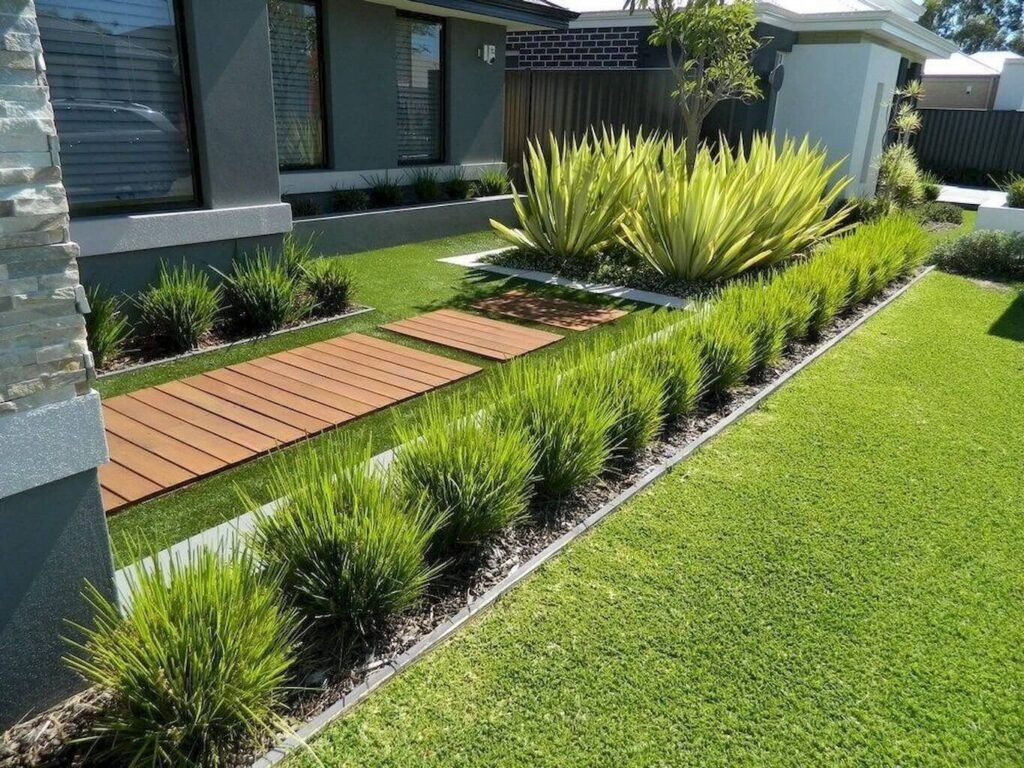
Understanding Modern Landscape Design
Principles of Modernism in Landscape Architecture
Minimalism and Simplicity:
Modern landscape design embraces minimalist principles, emphasizing clean lines, open spaces, and simplicity of design. By stripping away excess clutter and focusing on essential elements, modern landscapes achieve a sense of tranquility and sophistication.
Integration of Indoor and Outdoor Spaces:
Contemporary landscapes blur the boundaries between indoor and outdoor living areas, creating seamless transitions between the two. By integrating architectural features, materials, and design themes, modern landscapes enhance the flow and continuity between indoor and outdoor environments.
Elements of Contemporary Landscape Design
Clean Lines and Geometric Shapes:
Contemporary landscapes favor clean, crisp lines and geometric shapes over ornate detailing. Rectangular or square-shaped beds, linear pathways, and angular hardscape features contribute to a sense of order and modernity.
Sustainable and Low-Maintenance Features:
In response to environmental concerns, modern landscape design prioritizes sustainability and resource conservation. Low-maintenance plants, eco-friendly materials, and water-saving irrigation systems are integral components of contemporary outdoor spaces.
Incorporating Technology in Modern Landscapes Design
Smart Irrigation Systems and Outdoor Lighting
Efficient Water Management:
Smart irrigation systems use sensors and weather data to optimize watering schedules, reducing water waste and promoting healthy plant growth. Drip irrigation and soil moisture sensors ensure that plants receive the right amount of water at the right time, minimizing runoff and evaporation.
Customizable Lighting Solutions:
Advanced outdoor lighting systems allow homeowners to customize their outdoor environments with precision. LED fixtures, programmable controls, and color-changing options create ambiance and enhance safety while minimizing energy consumption.
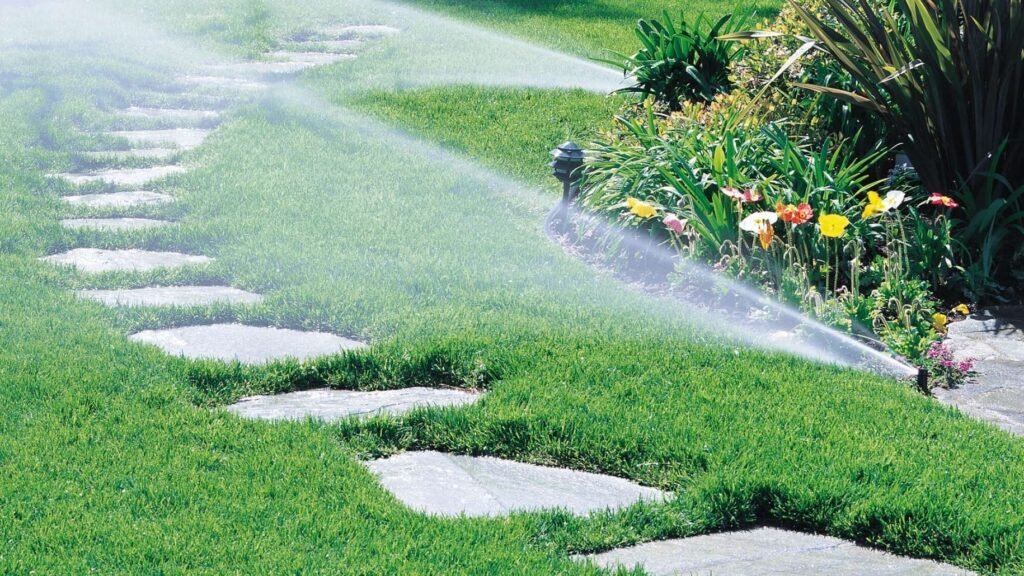
High-Tech Outdoor Entertainment
Integrated Audio and Visual Systems:
Outdoor entertainment spaces are equipped with state-of-the-art audio and visual systems, including weatherproof speakers, outdoor TVs, and wireless streaming capabilities. Whether hosting a backyard barbecue or a movie night under the stars, homeowners can enjoy immersive entertainment experiences in their outdoor oasis.
Automated Shade Structures:
Motorized awnings, pergolas, and retractable screens provide shade and shelter at the touch of a button. Automated systems adjust to changing weather conditions, ensuring comfort and convenience throughout the day.

Sustainable Practices in Modern Landscape Design
Drought-Tolerant Plantings and Xeriscaping
Native and Adaptive Plant Species:
Drought-tolerant plants, such as succulents, ornamental grasses, and native wildflowers, thrive in arid climates with minimal water requirements. Xeriscaping techniques, such as mulching and grouping plants according to water needs, further reduce irrigation needs and promote water conservation.
Permeable Paving and Rainwater Harvesting:
Permeable paving materials, such as permeable concrete, pavers, and gravel, allow rainwater to infiltrate the soil, replenishing groundwater supplies and reducing stormwater runoff. Rainwater harvesting systems capture and store rainwater for irrigation, reducing reliance on municipal water sources.
Eco-Friendly Materials and Construction Techniques
Recycled and Upcycled Materials:
Modern landscapes incorporate recycled and upcycled materials, such as reclaimed wood, recycled glass, and repurposed metal, to reduce environmental impact and promote sustainability. These materials add character and charm to outdoor spaces while minimizing waste and resource consumption.
Green Roof and Vertical Garden Installations:
Green roofs and vertical gardens provide additional opportunities for incorporating greenery into urban environments while reducing heat island effects and improving air quality. These living systems enhance biodiversity, mitigate stormwater runoff, and contribute to overall environmental sustainability.
Creating Functional Outdoor Living Spaces
Contemporary Outdoor Kitchens and Dining Areas
Sleek and Functional Kitchen Design:
Contemporary outdoor kitchens feature sleek, streamlined designs with high-performance appliances, durable countertops, and ample storage space. Integrated grills, refrigerators, and sinks allow homeowners to prepare and enjoy meals alfresco with ease.
Versatile Dining and Entertaining Spaces:
Flexible seating arrangements, comfortable furnishings, and versatile accessories create inviting outdoor dining and entertaining areas. From intimate gatherings to large-scale celebrations, modern outdoor spaces accommodate a variety of social activities and events.
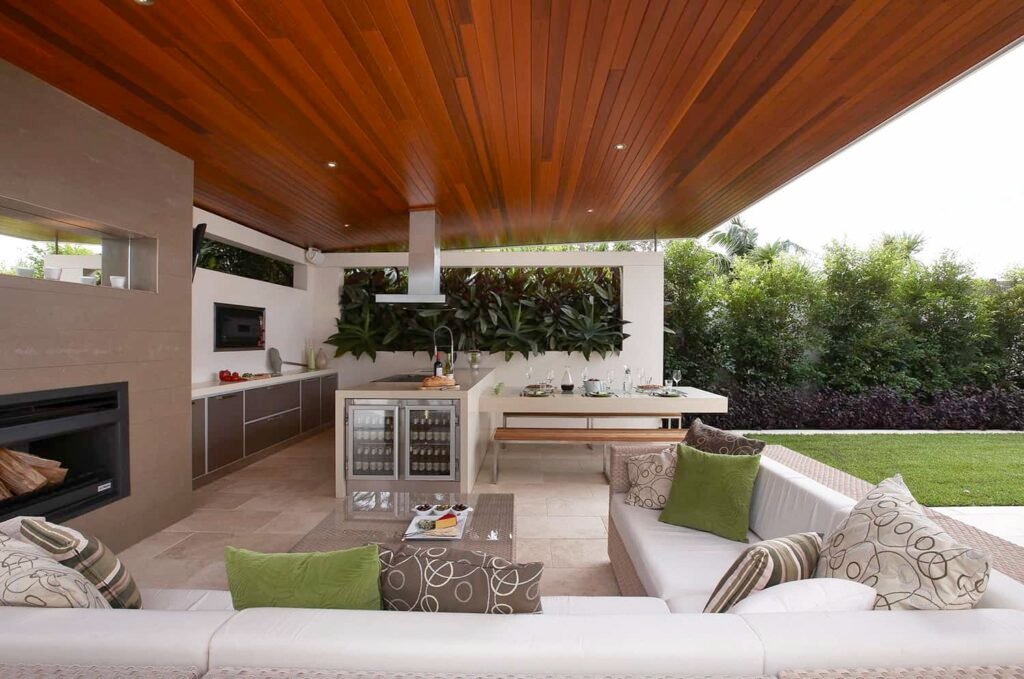
Relaxation and Recreation Zones
Zen-Inspired Meditation Gardens:
Tranquil meditation gardens offer a sanctuary for relaxation, reflection, and rejuvenation. Serene water features, lush plantings, and natural materials create a peaceful retreat where homeowners can escape the stresses of daily life and reconnect with nature.
Modern Swimming Pools and Spa Retreats:
Contemporary swimming pools and spa retreats combine sleek design with luxurious amenities for the ultimate outdoor relaxation experience. Infinity-edge pools, custom water features, and integrated spa systems create resort-like environments in the comfort of home.
Designing with Plants in Modern Landscapes
Architectural Plantings and Sculptural Elements
Ornamental Grasses and Structural Shrubs:
Architectural plantings, such as ornamental grasses, structural shrubs, and sculptural trees, add texture, dimension, and visual interest to modern landscapes. These bold, sculptural elements serve as focal points and anchor the design aesthetic, creating dynamic outdoor environments.
Statement Trees and Topiary Accents:
Statement trees, such as palms, Japanese maples, and flowering specimens, provide shade, scale, and seasonal interest in modern landscapes. Topiary accents, such as trimmed hedges and sculpted shrubs, add whimsy and charm to outdoor spaces, showcasing the artistry of plant selection and pruning.

Living Walls and Green Screens
Vertical Gardens for Small Spaces:
Living walls and green screens offer vertical gardening solutions for small or limited outdoor spaces. These vertical plantings maximize greenery without sacrificing square footage, providing privacy, shade, and visual interest in urban environments.
Privacy Screens and Natural Sound Barriers:
Living screens and green walls create natural partitions and sound barriers, enhancing privacy and seclusion in modern landscapes. Tall grasses, bamboo, and dense shrubs act as natural sound barriers, minimizing noise pollution and creating a tranquil outdoor environment.
Incorporating Art and Sculpture in Modern Gardens
Contemporary Art Installations
Sculptural Focal Points:
Contemporary art installations serve as focal points and conversation starters in modern gardens. Sculptures, kinetic art pieces, and interactive installations add visual interest and whimsy to outdoor spaces, inviting exploration and discovery.
Interactive and Kinetic Art Pieces:
Interactive and kinetic art pieces engage the senses and encourage interaction with the environment. Wind sculptures, water features, and kinetic installations respond to natural forces, creating dynamic and ever-changing outdoor experiences.
Water Features as Artistic Elements
Modernist Fountains and Reflective Pools:
Modernist fountains and reflective pools add movement, sound, and visual interest to contemporary landscapes. Sleek, geometric designs and minimalist detailing create dramatic focal points that complement the architectural style of the surrounding space.
Sculptural Water Walls and Cascades:
Sculptural water walls and cascades provide soothing sights and sounds in modern gardens. These architectural features use water as a sculptural medium, creating dynamic vertical elements that enhance the overall design aesthetic.
Frequently Asked Questions (FAQs)
What are the key characteristics of modern landscape design?
Modern landscape design emphasizes clean lines, minimalist aesthetics, and integration with indoor spaces. Sustainable practices, advanced technology, and functional outdoor living areas are also key characteristics of contemporary landscapes.
How can I incorporate sustainable practices into my modern landscape design?
To incorporate sustainable practices into your modern landscape design, consider using drought-tolerant plants, eco-friendly materials, and water-saving irrigation systems. Permeable paving, rainwater harvesting, and green roof installations are also effective ways to promote environmental sustainability.
What are some popular materials used in modern landscape construction?
Popular materials used in modern landscape construction include recycled and upcycled materials, such as reclaimed wood, recycled glass, and repurposed metal. Sustainable options like permeable concrete, eco-friendly decking, and composite materials are also common choices for contemporary outdoor spaces.
How can technology enhance the functionality of my outdoor space?
Technology can enhance the functionality of your outdoor space in various ways, such as smart irrigation systems, outdoor lighting controls, and integrated audiovisual systems. Automated shade structures, weather sensors, and remote monitoring capabilities also improve convenience and efficiency in modern landscapes.
Are there specific plant varieties that work best in Modern Landscape Design?
Certain plant varieties are well-suited to Modern Landscape Design due to their architectural forms, low maintenance requirements, and drought tolerance. Examples include ornamental grasses, succulents, structural shrubs, and statement trees like palms and Japanese maples.
Elevating Outdoor Living with Modern Landscape Design
Modern landscape design offers endless possibilities for transforming outdoor spaces into functional, sustainable, and visually stunning environments. By embracing minimalist principles, integrating advanced technology, and incorporating sustainable practices, homeowners can create outdoor retreats that reflect their lifestyle and enhance their well-being. Whether relaxing in a zen-inspired garden, entertaining in a contemporary outdoor kitchen, or admiring sculptural art installations, Modern Landscape Design provide endless opportunities for enjoyment and inspiration. Embrace the evolution of landscape design and elevate your outdoor living experience with modern style and sophistication.


